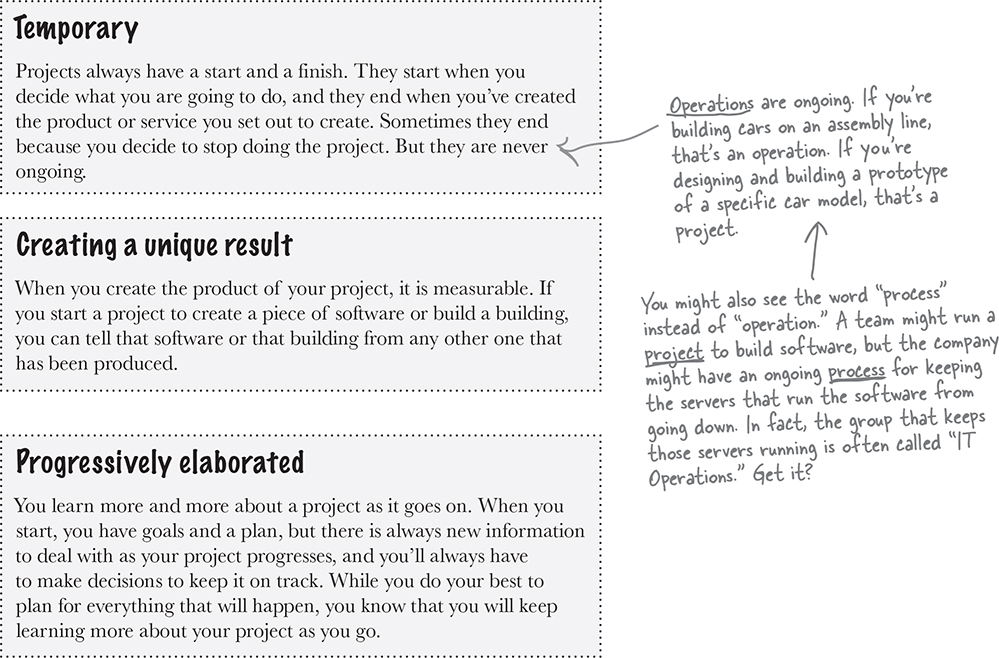Chapter 1. Introduction: Why get certified?

Tired of facing the same old problems? If you’ve worked on a lot of projects, you know that you face the same problems, over and over again. It’s time to learn some common solutions to those problems. There’s a whole lot that project managers have learned over the years, and passing the PMP exam is your ticket to putting that wisdom into practice. Get ready to change the way you manage your projects forever.
Do these problems seem familiar?
Kate’s boss promised a delivery date that she couldn’t possibly meet.
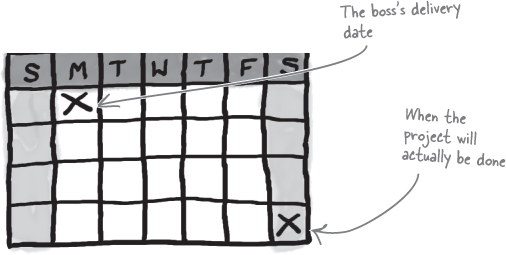

Then, when the project was halfway done, the customer demanded a big change.


Then, just as the project was about to be completed, someone noticed a couple typos, and 10,000 leaflets had to be reprinted.
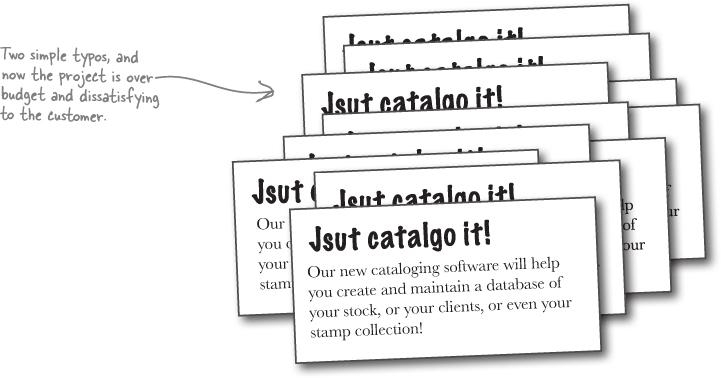
Then, when it was time to fix those typos, Kate realized that the printer was booked for another project.
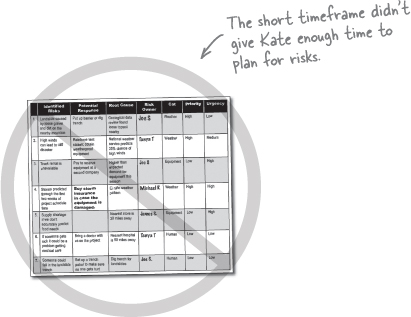
And even though she knew there was a pretty good chance that someone else might need the printer, she didn’t have time to come up with a backup plan.
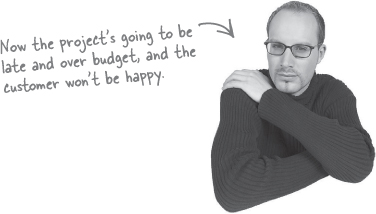
Projects don’t have to be this way
It may seem like all projects have these types of problems, but there are proven solutions to them…and someone else has already done a lot of the work for you! Realizing that all projects have common problems with solutions, a team of experts put together the PMBOK® Guide to pass those solutions on to you.
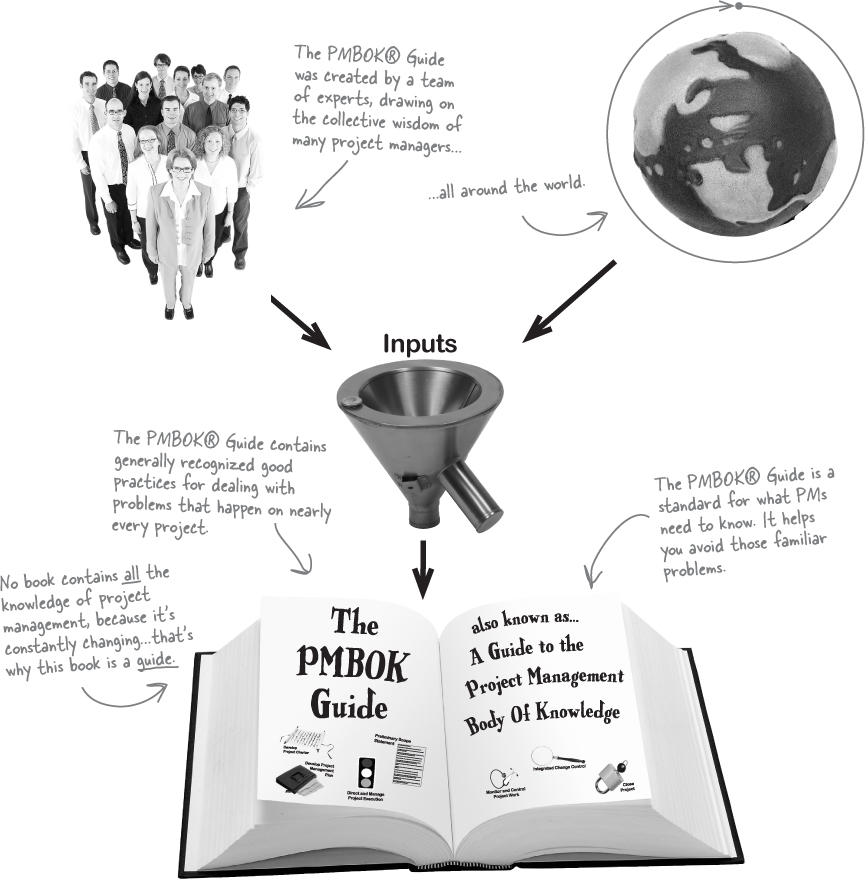
Your problems…already solved
Every project eventually runs into the same kinds of issues. But a project manager with good training can spot them early, and quickly figure out the best solutions. The PMBOK® Guide will help you:
✓ Learn from past projects that have run into similar problems to avoid running into them again.
✓ Learn a common vocabulary for project management that is used by PMs around the world.
✓ Plan and execute your projects to avoid common pitfalls.
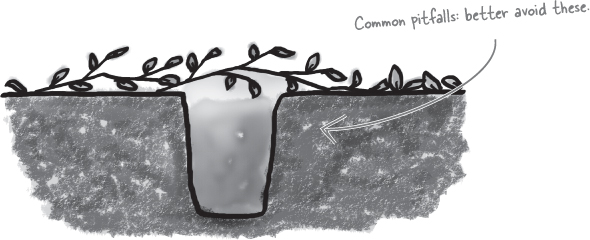
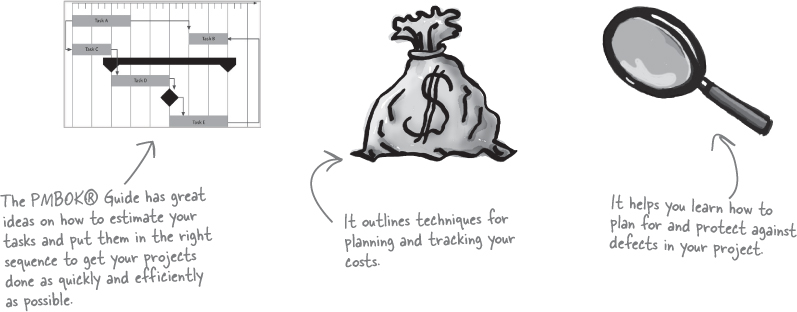
What you need to be a good project manager
The PMBOK® Guide is full of practical tools that can help you manage your projects better. But all of that doesn’t mean much if you don’t have the three core characteristics of a successful project manager. You’ve got to pay attention to all three if you want to make your project a success. This is what you’ll need if you’re going to take on the role of project manager:

there are no Dumb Questions
Q: How can the PMBOK® Guide claim to be the entire body of knowledge for project management?
A: Actually, it doesn’t claim that at all. That’s why the PMBOK® Guide is called “A Guide to the Project Management Body of Knowledge.” It’s a reference book that organizes a lot of information about how project managers do their jobs—but it doesn’t claim to have all the information itself. Instead, it provides you with a framework for managing projects and tells you what information you need to know.
A lot of people are surprised to find out that there are a bunch of things on the PMP exam that are never explicitly mentioned in the PMBOK® Guide. (Don’t worry: we’ll cover that stuff in the rest of this book.) There’s a whole lot of information that modern project managers should know about risk management and time management and cost and quality…and you’re expected to learn more about the knowledge areas as you move forward in your career. That’s why you should never limit your study to just what’s in the PMBOK® Guide. It’s meant only as a guide to all of the knowledge areas that project managers use on the job.
Q: What if I don’t do all of this stuff in my job?
A: The PMBOK® Guide isn’t necessarily meant to be followed like a recipe for every project. It’s a broad collection of many tools and processes that are used across the project management profession, and project managers have a lot of discretion about how they run their projects. So you shouldn’t throw out all that you’re doing at work and replace it with every single one of the tools in this book immediately. But you’ll notice as you go that some of the tools you’re learning about will solve problems for you on the job. When you find places where these tools can help, you really should start using them. Seriously, it’s the best way to learn. You might find that your projects go better after you start using a new concept that you learn while you study.
Q: I’ve heard that there are a whole bunch of formulas you have to memorize for the PMP exam. Will I have to do that?
A: Yes, but it won’t be that bad. The formulas are actually really useful. They help you understand how your project is doing so you can make better decisions. When you read about them later in the book, you’ll focus on how to use them and why. Once you know that, it’s not about memorizing a bunch of useless junk. The formulas will actually make sense, and you’ll find them intuitive and helpful in your day-to-day work.
Q: Aren’t certification exams just an excuse that consultants use so that they can charge their clients more money?
A: Some consultants charge more money because they are certified, but that’s not the only reason to get certified. The best reason to get PMP certification is because it helps you understand all of the project management concepts available to help you do your job better. If you learn these tools and apply them to your job, you will be a better project manager. And hey, if it turns out you can make more money too, that’s great.
What’s more, it’s worth keeping in mind that for a project manager, being PMP-certified is a requirement for a large amount of contracting work, especially in government, and it’s increasingly seen in job postings of all kinds. Some employers won’t even interview project managers who don’t have a PMP certification!
Q: Doing all of the stuff in the PMBOK® Guide seems like it will take a long time. How much of this really applies to me?
A: That’s a great question. You might find that there are documents that are mentioned in the PMBOK® Guide that you’re not used to writing or creating for your projects, and some planning steps that you’ve never taken before. That’s because the PMBOK® Guide is a framework, not a recipe for a successful project.
When you get your certification, it means that you have a solid understanding of all of the tools and techniques that are typically used by project managers to plan projects, track them, and deal with problems that come up along the way. It doesn’t mean that you follow the exact same recipe for project success every time you lead a project.
Q: But I work for a company that always runs projects on really tight deadlines. You can’t honestly expect me to write a bunch of project documents and use all of these formulas for my projects.
A: One of the useful things that you’ll learn in Chapter 8 of this book is that sometimes the processes that seem like a lot of work up front actually end up saving you time in the end.
If you find a problem in a two-hour planning meeting that would’ve cost you two weeks to fix, then that two hours you spent planning actually saved your project two weeks of time. A lot of the planning and documentation that you’ll be tested on is there to help you head off problems before they derail your project. So in the end, doing all of that work up front and writing it all down can actually make your project go faster and be cheaper than not doing it would’ve been!
The PMBOK® Guide is just a guide, but if you understand all the material in it, then you’ll ultimately be a better project manager.
Understand your company’s big picture
Your project is an important part of the work your company is doing, but you need to understand how it fits in to the higher-level strategy your company is executing, too. That’s where programs and portfolios come in.
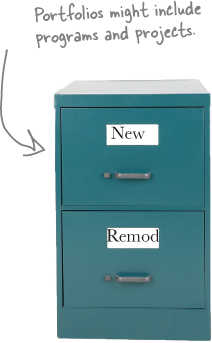
Portfolio
A portfolio is a group of projects or programs that are linked together by a business goal. If an architecture firm was venturing into remodeling existing buildings as well as designing new ones, it might split its efforts into separate New Construction and Remodeling portfolios, since the goals for each are quite different.
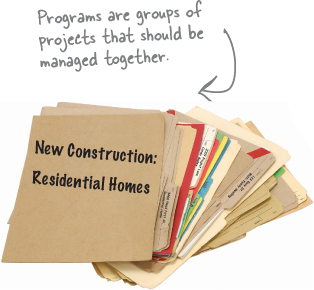
Program
A program is a group of projects that are closely linked, to the point where managing them together provides some benefit. The firm knows from experience that creating huge skyscrapers is dramatically different than building residential homes, so residential home construction would be its own separate program.
Note
Projects in a program are often dependent on each other. Program management focuses on these interdependencies.
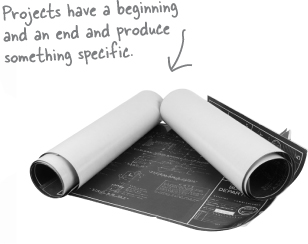
Project
A project is any work that produces a specific result and is temporary. Projects always have a beginning and an end. Building a house is a classic example of a project. Projects can be part of programs or portfolios, but portfolios and programs can’t be part of a project.
Your project has value
Think about the projects you’ve worked on in your career. Each one of them did something beneficial for your company. You might’ve created a product and sold it to customers to make money directly. You might’ve made someone’s job easier by automating work that would’ve taken time and effort to do. No matter how you count the benefit you created when you completed your project, that benefit is the real reason that your company decided to do the work in the first place. That benefit has an impact on the overall business value of the company you work for. Sometimes it can be easy to spend so much time dealing with your project’s issues that you lose track of the goals you set out to achieve. It’s important to think about the value of your project with every decision you make.
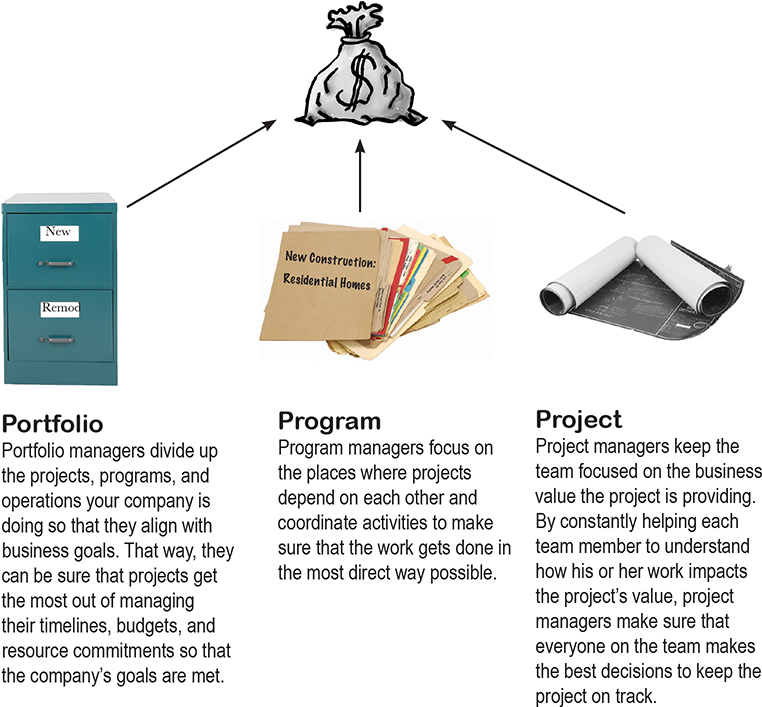
Business value is the sum of all of the things your company is made of, from desks and chairs to people and the intellectual property they produce.
Your project follows a lifecycle
The PMBOK® Guide defines a few patterns of work that projects follow. Those patterns are called lifecycles, and thinking about the lifecycle your project will follow determines a lot about the approach you’ll take to delivering the product you set out to create.
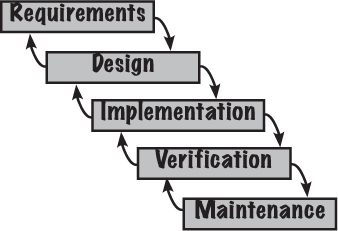
Predictive
In predictive lifecycles the project’s schedule, scope, and costs are defined up front. The early phases of the project determine how the rest of the project will be executed, and the project team does its best to execute the plan and minimize the impact of changes as they happen. Predictive lifecycles are all about predicting what will happen, preparing the best plan possible, and then working to follow it.
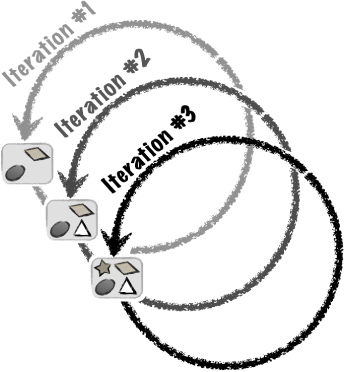
Adaptive
Adaptive lifecycles are all about change. Instead of planning the work and working the plan, teams that approach their work in an adaptive way repeatedly perform all project activities to deliver small pieces of the project that have value to its stakeholders. Those pieces are called increments, and most agile lifecycles are all about delivering valuable increments to customers as soon as possible. Because the lifecycle is repeatedly and frequently executed, change can happen without disrupting the work. The product of each iteration is an opportunity for feedback, and each iteration provides a means of changing the scope of the work that will be done.
Iterative
Iterative lifecycles are closer to predictive lifecycles than adaptive ones. When using an iterative approach, the team still tries to plan most of the work up front but uses repeated loops within the project lifecycle to identify possible changes to scope, schedule, and cost baselines. Those changes can be made throughout the project’s feedback loops.
Incremental
Teams that use incremental lifecycles deliver small, usable pieces of work to their stakeholders for feedback through a series of iterations. Incremental development lifecycles are much closer to adaptive ones but differ in that the increments produced here cannot be considered final products but must be combined in a final iteration to be considered complete.
Hybrid
The term hybrid describes any combination of predictive and adaptive approaches. Project managers often have an important role in helping the team decide which approach to take. You can follow one of the lifecycles defined here, or make a new combination of predictive and adaptive practices that better suits your organization.
Tailoring
Throughout this book, you’ll see advice on tailoring lifecycles. Each organization has a unique culture and set of considerations that affect all of the dimensions of project planning and execution. For each of the main chapters in this book, we’ll try to call out the types of questions you might ask yourself when thinking about which approach to use for your project.

Projects, programs, and portfolios have a lot in common
We’ve talked about the differences between portfolio management, program management, and project management, but there are a lot of similarities between them, too.
Professions with proven processes
Portfolio managers and program managers have a set of proven processes, tools, and techniques that have been used to manage many successful programs and portfolios. Like the PMP, the Project Management Institute offers certifications in Portfolio (PfMP) and Program Management (PgMP) too.
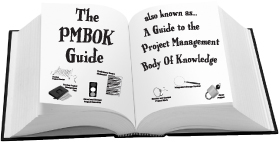
Business value
Portfolio managers prioritize work to meet a company’s strategic goals. Managing a program is all about keeping track of resources and other constraints affecting groups of projects so that all of those projects can achieve some shared benefit. Projects, on the other hand, are about managing the work to achieve some result. A portfolio’s strategic goals, a program’s shared benefit, and the result of that project all add business value to your company.

Deal with constraints
Portfolio managers need to prioritize work in environments with limited resources, budgets, risk tolerance, and many other constraints that set up the environment for their portfolio’s success. Program managers need to manage groups of projects that are being produced by the same resource pool or from the same budget. Project managers often have predefined schedules, resource constraints, and scope requirements to manage. All three need to use the processes, tools, and techniques that have worked for other managers to balance all of the constraints in their business environments.

Projects, programs, and portfolios all use charters
All of the work you do to initiate, plan, execute, control, and close your project helps your program and portfolio managers understand how your project is doing and keep it on track. Following all of the processes in the PMBOK® Guide will ensure that the programs and portfolios of which your project is a part always know how you’re doing and what you’ll accomplish. While there are many differences in the documents that are used in portfolio and program management, all three use a charter to define their objectives.
Charter
Portfolios, programs, and projects all use a charter to define their goals and initiate work. A charter lists any known constraints and goals and gives the manager authority to get the work started.
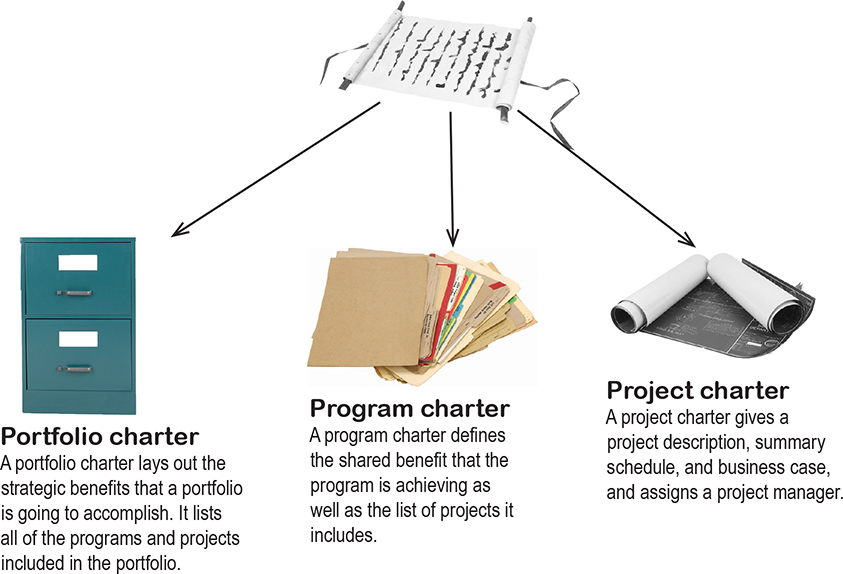
… and what a project is NOT
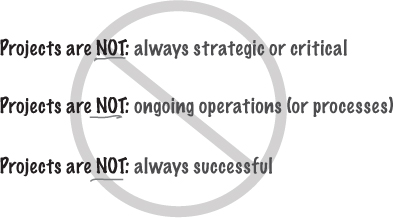
A day in the life of a project manager
You probably already know a lot of what a project manager does: gets a project from concept to completed product. Usually a project manager works with a team of people to get the work done. And PMs don’t usually know a lot about the project when they start. When you think about it, you can categorize pretty much everything a project manager does every day into three categories.
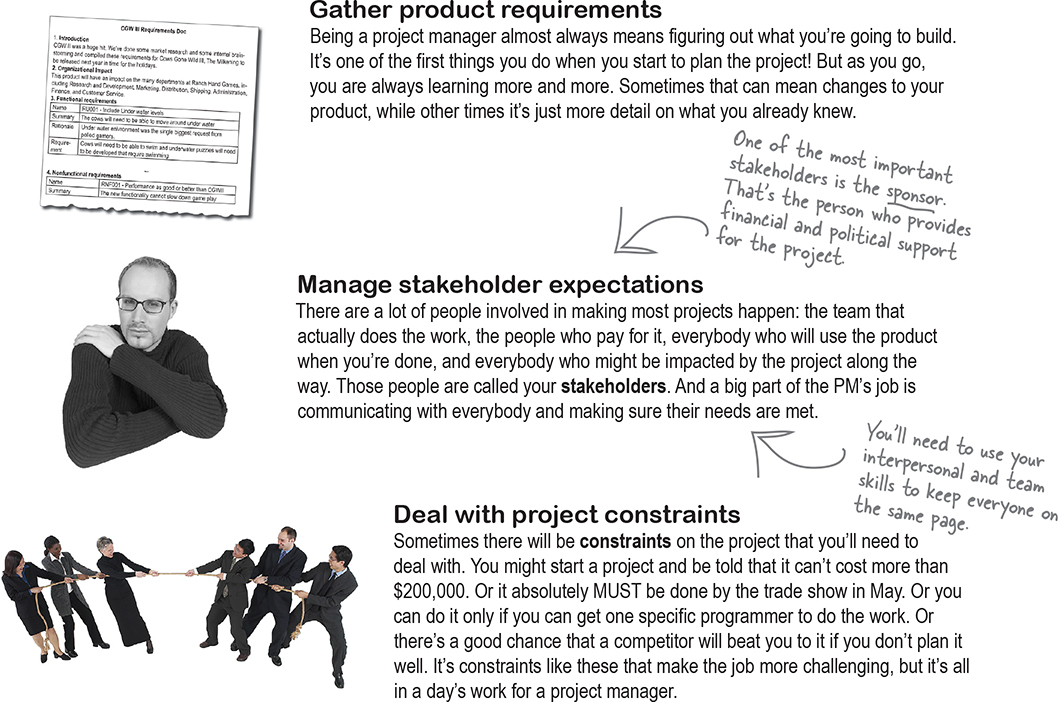
Even though you’re constantly gathering requirements, managing stakeholders, and working within constraints, different situations can call for different tools for dealing with all of those challenges. When you think about it, all of the tools and techniques that are discussed in the PMBOK® Guide are there to help you do those three things at different points in your project’s lifecycle. That’s why the PMBOK® Guide divides up the work you do on a project into the five process groups. The groups help you organize all of the work you do as your project progresses and keep your role in the project straight.
Note
You’ll learn all about the process groups in Chapter 3!
there are no Dumb Questions
Q: Do project constraints just mean restrictions on time and cost?
A: No. A project constraint is any limitation that’s placed on your project before you start doing the work. It’s true that project managers are really familiar with time and cost constraints, because those are really common. But there are lots of other kinds of constraints, too.
Here’s an example. Let’s say that some of your team members won’t be available for three weeks because they have to attend a mandatory training session. That’s called a resource constraint, because some of your project resources (people you need) are restricted.
There are lots of other kinds of constraints, too: risk constraints, scope constraints, and quality constraints.
Q: Wait a minute—a quality constraint? Shouldn’t I always run my project to build high-quality products?
A: Of course. But quality is more important for some projects than it is for others, and as a project manager, you need to be realistic about it.
If you’re running a project to build a playground, quality is important. You don’t want to build unsafe playground equipment, because children could get hurt. Does that mean that you spend the highest possible portion of your budget on quality? Take a minute and think about how you’d approach quality for that project, as compared to, say, a project to build a heart monitor for a medical device company. It’s likely that quality is a much more important constraint for the heart monitor than it is for the playground.
How project managers run great projects
There are plenty of ways that you can run a project; people have been running projects for about as long as civilization has been around. But some project managers run their projects really effectively, while others consistently come in late, over budget, and with poor quality. So what makes the difference between a great project and one that faces challenges?
That’s exactly the question that the folks at the Project Management Institute asked when they started putting together their Guide to the Project Management Body of Knowledge. They surveyed thousands of project managers and analyzed tens of thousands of successful and unsuccessful projects to come up with a structured way of thinking about how to effectively run a project.
One goal of the PMBOK® Guide is to give you a repeatable way to run your projects. It does so by breaking the work down into 49 processes that describe different, specific kinds of work that project managers do. To help you understand how those processes fit together, they came up with two different ways to think about them. Each process falls into one of the five process groups, which tell you the sequence in which the processes are performed on a project. But the PMBOK® Guide is also a tool for organizing knowledge about project management, so each process also falls into one of 10 knowledge areas. The PMBOK® Guide is organized around these knowledge areas…and so is this book!
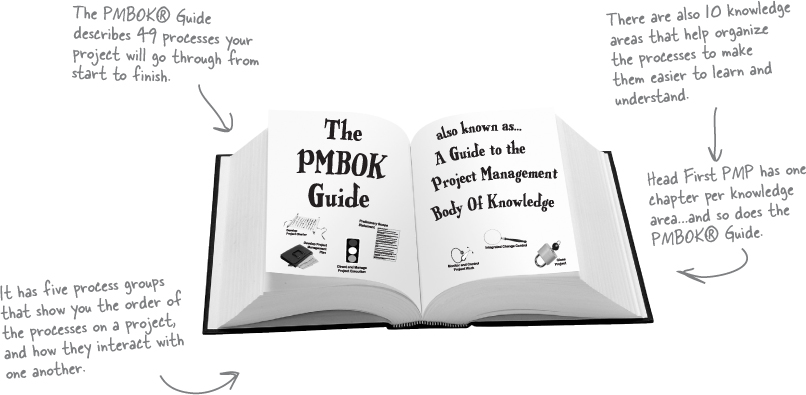
Each process is assigned to a process group, and it’s also in a knowledge area.
Project management offices help you do a good job, every time
Every project your company completes can teach you a lot about what works and what doesn’t within your company’s culture. Project management offices (PMOs) help you to learn from all of the work that’s been done in the past. They’ll give you the templates and the guidance you need to make sure your project takes the right approach and makes sense to everyone you work with. There are three different kinds of PMOs that you might run into in your career.
Supportive
PMOs that play a supportive role provide all of the templates you need to fill out while your project is under way. They’ll lay out the standards for how you should communicate your project’s scope, resources, schedule, and status as your project progresses from its initial stages through to delivery and closing.

Controlling
PMOs that control the way project management is done in a company will be able to check that you’re following the processes they prescribe. Like supportive PMOs, they’ll tell you what templates you should fill out and prescribe a framework for doing project management in your company. They’ll also periodically review the work that you’re doing on your project to make sure you’re following their guidelines.

Directive
PMOs that take a directive approach actually provide project managers to project teams. In a directive PMO, the project manager usually reports to the PMO directly. That reporting structure makes sure that the project managers follow the frameworks and templates prescribed by the PMO, because their job performance depends on it.
Note
Directive PMOs have a lot of control over the way things are done on projects.

Good leadership helps the team work together
It’s not enough to have a good plan and all the resources you need to make your project a success. You need to think about your interpersonal and team skills if you want to keep your project on track. Here are a few examples:
Leadership
A good leader gets the team to see the end goal and focus on getting there. With the right leadership, team members feel like they can take control of the work they’re doing, and make good decisions to help the team achieve its goals as directly as possible.
Team building and trust building
Everything you do to help team members feel like they can rely on one another is part of team building. When a team feels like they’re all working together to achieve the project’s goals, they’re able to do so much more than each member can do individually. Trust building is all about sharing information with all of your stakeholders so that they know they can trust one another.

Motivation
Some people are motivated by the kind of work they do, some are looking for experience that will help their résumés, and others are hoping for a promotion or a pay raise. Understanding what motivates your team members and helping them to achieve their personal goals will help your project, too.
Note
Some teams can be so motivated by the value of the project that their personal goals are secondary to making the project a success. When that happens, they can be really productive as a team.
Project teams are made of people
Keeping your team motivated and helping them to feel included are just a couple of the interpersonal and team skills that make your project a success. You also need to help your team members work through problems and maintain an environment where it’s easy for everyone to get along. Here are a few more interpersonal and team skills that a good project manager uses to keep the team on track:
Influencing
Sometimes you need to collaborate with others to get your work done. When you influence people, you focus on the shared benefit of the work with them and share power toward a common goal. You’re probably using your influence to make things happen every day on the job.
Note
You usually can’t just tell people to do what you want and have them do it.
Conflict management
When people work together, there will always be disagreements. A good project manager works to find positive solutions when conflicts pop up.
Note
We’ll talk more about conflict management in Chapter 14.
There are a few more interpersonal and team skills discussed in the PMBOK® Guide that we’ll talk about along the way:
* Communication (Chapter 10 is all about communication).
* Negotiation and decision making (we’ll talk more about those in Chapter 9).
Coaching
As the people on your team grow and take on new responsibilities, they might want some help developing new skills. That’s where coaching comes in. When you coach people, you help them develop their skills and get better at what they do. Sometimes this means helping them find training, while other times it’s just acting as a sounding board to help your team members sort through the problems they run into.
Note
A good PM is always looking for ways to help the team get better at what they do.
Political and cultural awareness
It’s important to make sure that everybody on the team feels included. You need to be aware of the topics that might alienate people or make them feel uncomfortable, so that you can maintain an open and inclusive environment on your team.
there are no Dumb Questions
Q: Directive and controlling PMOs seem pretty similar to me. What’s the difference again?
A: That’s a good question. Both of them are pretty active in managing the projects they govern, but there are some differences.
Controlling PMOs tend to review the work a project team does at various points in the project to make sure that they are following the company’s agreed-upon process. The people who work in the controlling PMO are like auditors who take a look at a project team’s work products to make sure they’re complying with the company’s project management rules.
Directive PMOs actually manage the projects on their own. The people who work in the PMO take on the role of project manager for all of the projects the PMO is responsible for.
Q: My company doesn’t have a PMO at all. Do the 49 processes apply only to companies that have PMOs? How much of what’s in the PMBOK® Guide applies to plain old project managers who aren’t in a PMO?
A: Yes! The PMBOK® Guide is all about project management, and all of the processes it talks about are meant to be used on projects to help them succeed. If your company has a PMO, following the 49 processes will help you work with that PMO. But if you don’t have a PMO where you work, it’s still good for a project to follow all 49 of them.
Q: Does the PMP exam test you on your interpersonal and team skills?
A: Yes. You need to know what all of the interpersonal and team skills are and when you would use them in managing your project. Interpersonal and team skills are an important part of managing a team. If your team members each feel like their opinion is valued and they are motivated to do good work, you’ll have a much better chance at success.
Q: Hold on, how are team building and coaching different?
A: Another good question. Team building usually means going out, having lunch, doing group exercises, and in general socializing as a team so that the group gets more familiar with one another and can have a better internal set of relationships. Coaching is about identifying your team members’ talents and helping them develop those.
Say a member of your team is really good at explaining technical concepts to other people. You might want to coach that person to write project documents that will help the whole team understand what they’re doing better. That would let the team member get better at using her talent, and also help with team communication.
Operations management handles the processes that make your company tick
Think about all of the processes your company goes through every day to keep things running smoothly. You probably have worked with operations teams on many of your projects—from accounting departments to support teams to infrastructure teams who maintain software environments. Each operations team is staffed with specialists in the aspect of your company that they run. Sometimes, you’ll work with them to build out parts of your project; sometimes, you’ll depend on them to do work before your project can proceed. Operations teams are almost always stakeholders in your projects.
Note
You’ll learn more about stakeholders when we talk about stakeholder management in Chapter 13.
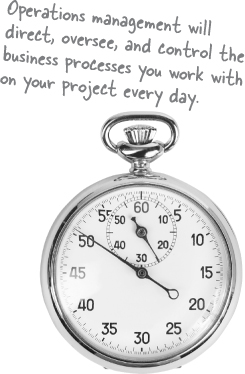
A PMP certification is more than just passing a test
Meet a real-life PMP-certified project manager
PMs have demonstrated that they understand the tools it takes to be successful at leading projects. They know what it means to juggle their project priorities and still have their projects come out on top. Being certified doesn’t mean you won’t have problems on your projects anymore, but it does mean that you’ll have the wisdom of many experienced and smart project managers behind you when you make decisions about how to solve these problems.
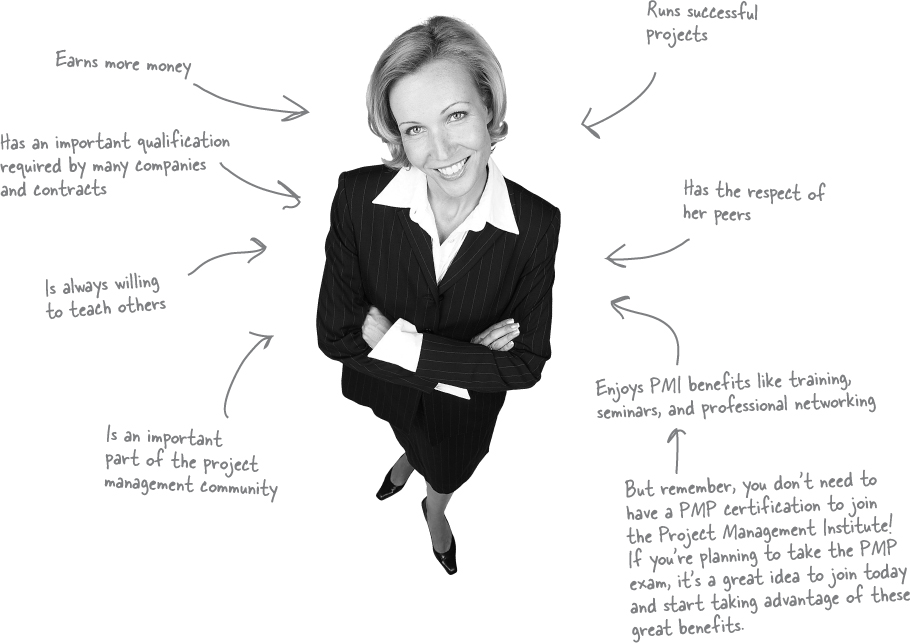
This could be YOU!
Exam Questions
Which of the following is NOT a type of project management office?
Directive
Value-driven
Supportive
Controlling
Which of the following is NOT a distinguishing characteristic of a project?
Temporary
Strategic
Specific result
Progressively elaborated
An energy company is investing in a series of initiatives to look for alternative energy sources so that the company can be competitive in 10 years. The initiatives are tracked and managed together because this goal is vital to the success of the company. This is an example of:
A portfolio
A program
A project
A enterprise environmental factor
Which of the following is NOT a responsibility of a project manager?
Managing stakeholder expectations
Managing project constraints
Gathering product requirements
Sponsoring the project
Which of the following is NOT an interpersonal skill?
Motivation
Brainstorming
Team building
Coaching
Which of the following is NOT true about interpersonal and team skills?
Coaching means helping your team to get more exercise.
Motivation means helping team members get what they want out of the project.
Influencing means sharing power with people to get something done.
Conflict management means finding positive solutions to conflicts during the project.
Which of the following is NOT true about portfolio management?
The portfolio manager judges the success of the portfolio by combining data from all of its programs and projects.
A portfolio can contain projects and programs.
A portfolio is organized around a business goal.
A portfolio is always a group of programs.
You’re managing a project to remodel a kitchen. You use earned value calculations to figure out that you’re going to run $500 over budget if your project continues at the current rate. Which of the following core characteristics of a project manager are you using to find the problem?
Knowledge
Performance
Personal
None of the above
At the beginning of a project, a software team project manager is given a schedule with everyone’s vacations on it. She realizes that because the software will be delivered to the QA team exactly when they have overlapping vacations, there is a serious risk of quality problems, because there won’t be anyone to test the software before it goes into production. What BEST describes the constraint this places on the project?
Quality constraint
Time constraint
Resource constraint
Risk constraint
A project manager is having trouble with his project because one of his team members is not performing, which is causing him to miss an important date he promised to a stakeholder. He discovers that the team member knew about the project problem, but didn’t tell him because the team members are all afraid of his bad temper. Which BEST describes how the project manager can avoid this situation in the future?
Increasing his knowledge of the PMBOK® Guide
Measuring personal performance
Improving his personal skills
Managing stakeholder expectations
Exam Answers
Answer: B
Although PMOs are usually value-driven, that’s not a valid type of PMO. The three types of PMOs are supportive, controlling, and directive. Supportive PMOs provide templates and guidelines for running projects, controlling PMOs audit projects to ensure adherence to processes and standards, and directive PMOs provide project managers to manage projects.
Answer: B
A project doesn’t have to be strategic or critical. It only needs to be temporary, have a specific result, and be progressively elaborated.
Note
Look out for questions like this one on the exam. Common sense might tell you that a project should be important for a company to want to do it, but that’s not what the question is asking.
Answer: A
Since the initiatives are being managed together because of a strategic business goal, you can tell that this is a portfolio.
Note
Portfolios are organized around business goals, and programs are organized around a shared benefit in managing them together.
Answer: D
The sponsor is the person who pays for the project. The project manager doesn’t usually play that role.
Answer: B
Brainstorming is an activity that you do with other people, but it’s not an interpersonal skill that you need to hone to help manage all of the stakeholders on your project.
Note
In fact, you’ll learn more about its role in defining project requirements in a couple of chapters.
Answer: A
Coaching is really about helping your team members to get better at what they do. Anything you do to challenge them to develop their skills is coaching.
Answer: D
Since a portfolio can be a group of programs and projects, option D is the one that’s not true. It can be a group of programs, but it doesn’t have to be.
Answer: A
Your knowledge of earned value management techniques is how you can predict that the project will be over budget. Knowing that could help you plan ahead to avoid further cost overruns. Minimally, it can help you to reset expectations with your stakeholders so they have a better idea of what’s coming.
Answer: C
This is a resource constraint, because the project manager’s resources—in this case, the people who will be testing the software—are not going to be available to her when she needs them. Yes, this will cause problems with the quality, introduce risks, and cause schedule problems. But they’re not schedule, time, or risk constraints, because there’s no outside limitation placed on the project quality, schedule, or risks. The only outside limitation is the resource availability. If they were available, there wouldn’t be a problem!
Answer: C
The way that the project manager interacts with the people on his team interfered with his work getting done. This is a good example of how a lack of personal skills can lead directly to major project problems down the line, and it’s why this particular project manager needs to work on his personal skills.
Note
The project manager’s temper led to a disappointed stakeholder, but that doesn’t mean that the stakeholder’s expectations were out of line. This was an avoidable project problem, and better personal skills would have fixed it.

Get Head First PMP, 4th Edition now with the O’Reilly learning platform.
O’Reilly members experience books, live events, courses curated by job role, and more from O’Reilly and nearly 200 top publishers.
